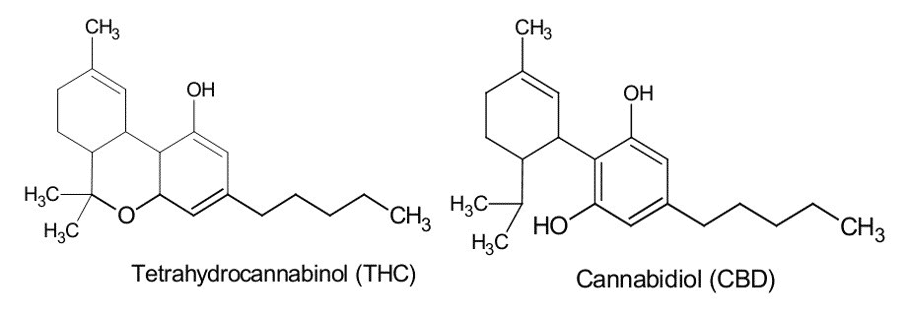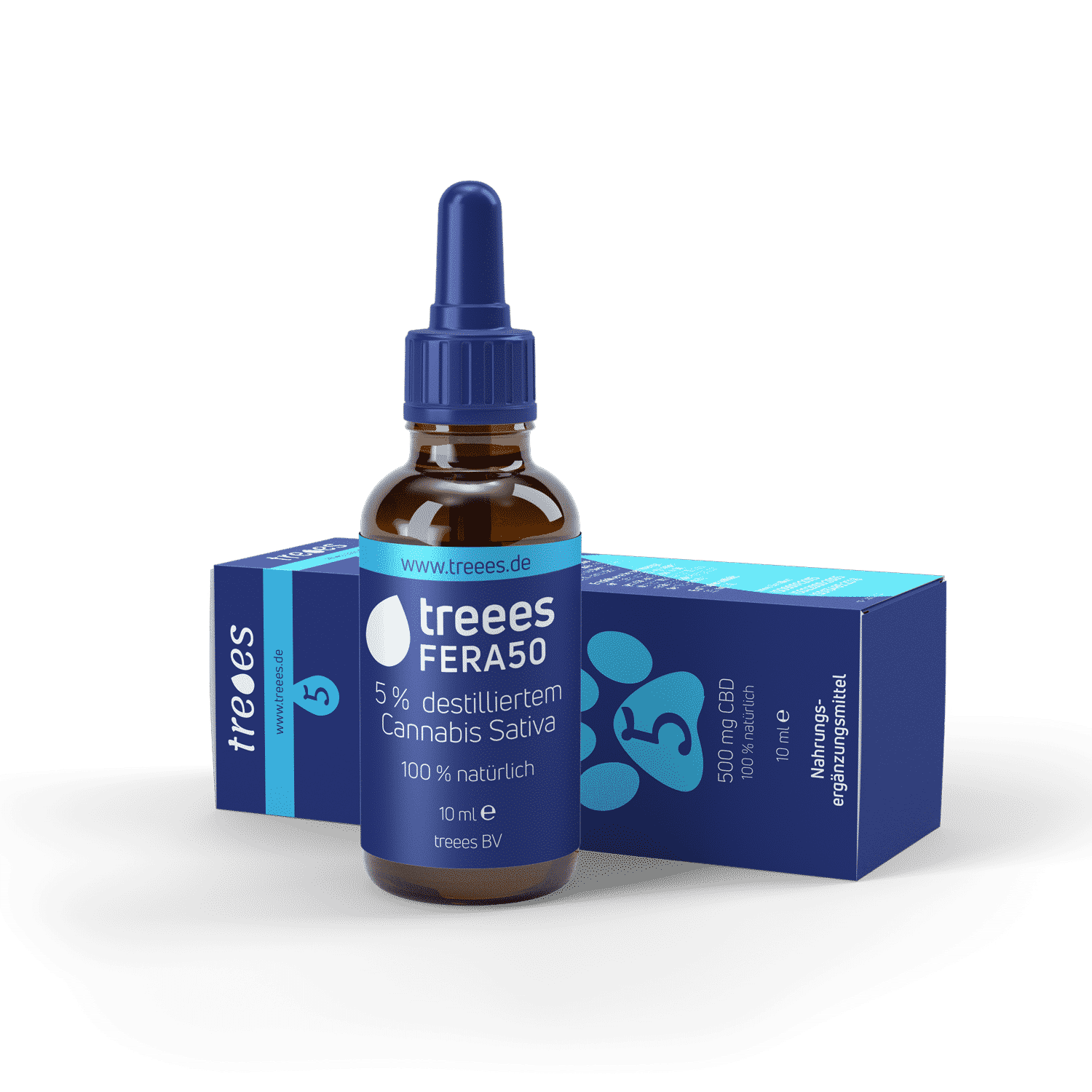How does CBD work in the human body?
The non-psychoactive ingredient cannabidiol binds to various receptor systems in the endocannabinoid system. This can be seen as a communication system that acts between the body and the brain and consists of various receptors to which molecules dock to ensure the mediation of signals.
Within this system, endocannabinoids act, so-called active substances that are produced by the body itself. In addition, there are exogenous cannabinoids that closely resemble human ones and act in a similar way in the endocannabinoid system, but must be supplied from outside. Regardless of whether they are produced by the body or supplied, the respective substances bind to the receptors to activate different processes [1].
not in the mood for reading?
ZDF and Terra X have made a contribution. (But it’s in German)
Difference between CBD and THC
CBD and THC are two of the most well-known ingredients of the hemp plant. Compared to CBD, THC is responsible for the controversial psychological effects of cannabis. THC, like CBD, also binds to the CB1 and CB2 receptors [2]. However, compared to THC, CBD is not psychoactive and may even counteract the psychic effects of THC in high doses, as well as enhance the analgesic properties of THC. Other phytocannabinoids, such as CBG or CBN, also exert pharmacological effects, but have no or very little psychic effect [3].
The following diagram illustrates the chemical structure of THC and CBD, which is very similar:

In summary, CBD is considered an effective, well-tolerated and above all safe component of the hemp plant and is particularly interesting for self-medication, due to the diverse spectrum of effects without depressing side effects. The use of cannabidiol therefore enjoys increasing popularity in the complementary field.
Selection of the most significant mechanisms of action of CBD researched to date.
- CBD, like capsaicin, stimulates the vanilloid receptor type1. This stimulation may contribute to an analgesic effect [5]. This is according to the study by Bisogno T, Hanus L, De Petrocellis L, Tchilibon S, Ponde DE, Brandi I, Moriello AS, Davis JB, Mechoulam R, Di Marzo.
- CBD binds to nucleoside transporter-1 and enhances adenosine signaling, harmonizing increased neurotransmitter release (norepinephrine, epinephrine) [6].
- CBD binds to the GPR55 receptor, complementing its anti-inflammatory effects [7].
- Cannabinoids, including CBD, are potent free radical scavengers and have cell-protective properties [8].
Other significant potential mechanisms of action of CBD:
- Antibacterial [9]
- Lowering blood pressure [10]
- Relieves vomiting and nausea[11]
- Inhibits cell growth in tumors and cancer cells [12]
- Relieves psoriasis [13]
- Promotes bone growth [14]
- Boost the immune system [15]
- Neuroprotective [16]
Application & use
As already mentioned in the previous paragraph, CBD can be used both complementarily and preventively, for health promotion, with a very broad spectrum of effects. There are already a number of freely available preparations for this, ranging from teas to cosmetics and oils for oral use.
CBD oils and capsules are particularly popular – these can be ideally integrated into everyday life. The number of droplets can be adapted to your own needs through individual dosing using a pipette. The capsules prove to be a practical companion, especially on the go or when traveling.
But cosmetic products containing CBD are also ideal for external application through the skin. Especially with regard to certain skin diseases and inflammations, these can be recommended as a complementary treatment.
But how much CBD can you consume every day? Is Too Much CBD Dangerous?
consumption recommendation
The dosage of CBD is very individual and can cause different effects depending on the person. Unless otherwise prescribed, a small daily dose is equivalent to around 18 mg of CBD.
Even small doses can be beneficial if the terpene entourage effect is used.
Therefore, unless otherwise prescribed, adhere to the consumption recommendations given on the product. You can increase this gradually as required until the desired effect is achieved and you have thus found your ideal dosage [17].
Application examples according to complementary empirical medicine
The following is a list of possible diseases and complaints for which the intake of CBD can have a beneficial effect:
| CBD Konzentrate 5% |
|
|---|---|
| CBD Konzentrate 10% |
|
The use of CBD concentrates with 18% or 24% is mostly done when higher CBD dosages are necessary to achieve the health goal.
This extract is only an orientation and serves as a guideline. General statements can hardly be made with regard to the correct dosage and concentration, since each body reacts differently sensitive to it. In most cases, even small dosages can be successful [17].
The following factors influence the correct dosage:
- Health target
- Stage of the disease
- Biology and metabolism of the patient
- Patient’s subjective sensation/sensitivity as the most important factor
- Endocannabinoid system of the patient: Functioning and response to CBD
- Body weight
- Body chemistry, including medications and foods taken [18].
There are already a large number of studies that point to the positive effects of CBD and also confirm them. However, the studies were mostly conducted with small numbers of cases, on animals or on isolated cells in the laboratory. Further clinical research is therefore needed here. However, the interest and the need for such studies are increasing [17].
CBD also for animals?
In addition to humans, animals can also benefit from the diverse range of effects of CBD. Like humans, animals also have their own endocannabinoid system, which is why more and more pet owners are turning to CBD oils.
Dogs in particular are unique in terms of the endocannabinoid system, as they have a higher concentration of receptors in the cerebellum and brainstem than other species, making them ideal candidates. The concentration or dosage of cannabis products in animals is basically dependent on body weight and turns out to be lower than in humans.
Furthermore, it should be mentioned that dogs, and especially cats, do not tolerate theobromine. Theobromine is contained in chocolate, among other things. Its consumption can cause poisoning and initiate various metabolic processes [19]. Dogs and cats are therefore very sensitive to certain substances.
Sources and studies
[1] Pleyer I., et al. (2019). Cannabidiol: Ein natürliches Heilmittel des Hanfs. Wien: Verlagshaus der Ärzte
[2] Grotenhermen, et al. (2015). Cannabidiol – CBD – Ein cannabishaltiges Compendium. Solothurn: Nachtschattenverlag
[3] Grotenhermen, F. (2015). Hanf als Medizin. Ein praxisorientierter Ratgeber. Nachschattenverlag: Solothurn
[4] Patel, R. (2019). Gesund mit CBD-Öl. Das Wundermittel gegen Stress, Schmerzen, Schlafstörungen und mehr. Penguin Random House: München
[5] Bisogno et al. Molecular targets for cannabidol and ist synthetic analogues: effect on the cellular uptake and enzymatic hydrolysis of anandamide. Download vom 16. Jänner 2020
[6] Malfait AM., et al. (2015). The nonpsychoactive cannabis constituent cannabidiol is an oral anti-arthritic therapeutic in murine collagen-induced arthritis. Download vom 16. Jänner 2020
[7] Li K., et al. Anti-inflammatory role of cannabidiol and O-1602 in cerulein-induced acute pancreatitis in mice. Download vom 16. Jänner 2020
[8] Hacke A., et al. (2019). Probing the antioxidant activity of Δ9- tetrahydrocannabinol and cannabidiol in Cannabis sativa extracts. Download vom 18. Februar 2020
[9] American Society for Microbiology. (2019). Cannabidiol is a powerful new antibiotic. Download vom 12. Februar 2020
[10] Jadoon K., et al. (2017). A single dose of cannabidiol reduces blood pressure in healthy volunteers in a randomized crossover study. 2(12). Download vom 12. Februar 2020
[11] Parker, L., Rock, E., Limebeer, C. (2011). Regulation of Nausea and vomiting by cannabinoids. 163(7): 1411–1422. Download vom 12. Februar 2020
[12]. Daris B., et al. (2019). Cannabinoids in Cancer Treatment: Therapeutic Potential and legislation. Download vom 12. Februar 2020
[13] [16] Elsaid S., et al. (2019). Chapter Two – Effects of cannabidiol (CBD) in neuropsychiatric disorders: A review of pre-clinical and clinical findings. Download vom 12. Februar 2020
[14] Kogan N., et. al. (2015). Cannabidiol, a Major Non-Psychotropic Cannabis Constituent Enhances Fracture Healing and Stimulates Lysyl Hyrdoxylase Activity in Osteoblasts. Download vom 12. Februar 2020
[15] Croxford, J., & Yamamura, T. (2005). Cannabinoids and the immune System: Potential for the treatment of inflammatory diseases? Journal of Neuroimmunology 166 (2005) 3 – 18. Download vom 12. Februar 2020
[17] Wanitschek, A. & Vigl, S. (2018). Cannabis und Cannabidiol (CBD) richtig anwenden. Wirkungsweisen und Behandlungsmethoden verständlich erklärt. Wien: Humboldt Verlag
[18] Leinow, L & Birnbaum, J. (2019). Heilen mit CBD. Das wissenschaftlich fundierte Handbuch zur medizinischen Anwendung von Cannabidiol. München: Riva Verlag
[19] Waitz, M. (2018). Schokoladenvergiftung bei Hunden und Katzen. Download vom 20. Februar 2020, von https://www.tiermedizinportal.de/magazin/schokoladenvergiftung-bei-hunden-und-katzen/131713
https://treees.de/en/disclaimer/



